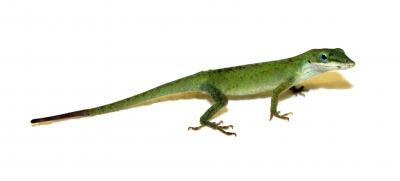A team of researchers is a step closer to solving the mystery of how lizards regenerate their tails. They have found the genetic "recipe", which involves genetic ingredients in just the right mixture and amounts.
The scientists used molecular and computer analysis tools to examine the genes turned on in tail regeneration. The team studied the regenerating tail of the green anole lizard (Anolis carolinensis), which when caught by a predator, can lose its tail and then grow it back.
"Lizards basically share the same toolbox of genes as humans," said senior author Kenro Kusumi, professor Arizona State University. "Lizards are the most closely-related animals to humans that can regenerate entire appendages. We discovered that they turn on at least 326 genes in specific regions of the regenerating tail, including genes involved in embryonic development, response to hormonal signals and wound healing."

The green anole lizard (Anolis carolinensis), when caught by a predator, can lose its tail and then grow it back. Researchers have discovered the genetic 'recipe' as to how this happens. Credit: Joel Robertson
Other animals, such as salamanders, frog tadpoles and fish, can also regenerate their tails, with growth mostly at the tip. During tail regeneration, they all turn on genes in what is called the 'Wnt pathway' — a process that is required to control stem cells in many organs such as the brain, hair follicles and blood vessels. However, lizards have a unique pattern of tissue growth that is distributed throughout the tail.
"Regeneration is not an instant process," said Elizabeth Hutchins, a graduate student in ASU's molecular and cellular biology program and co-author of the paper. "In fact, it takes lizards more than 60 days to regenerate a functional tail. Lizards form a complex regenerating structure with cells growing into tissues at a number of sites along the tail."
"We have identified one type of cell that is important for tissue regeneration," said Jeanne Wilson-Rawls, co-author and associate professor with ASU's School of Life Sciences. "Just like in mice and humans, lizards have satellite cells that can grow and develop into skeletal muscle and other tissues."
"Using next-generation technologies to sequence all the genes expressed during regeneration, we have unlocked the mystery of what genes are needed to regrow the lizard tail," said Kusumi. "By following the genetic recipe for regeneration that is found in lizards, and then harnessing those same genes in human cells, it may be possible to regrow new cartilage, muscle or even spinal cord in the future."
The researchers hope their findings will help lead to discoveries of new therapeutic approaches to spinal cord injuries, repairing birth defects, and treating diseases such as arthritis.






Comments